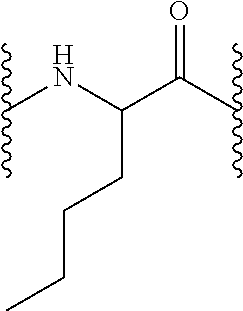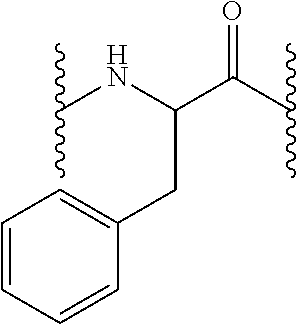Cosmetic or pharmaceutical compositions including tripeptides capable of stimulating cyclic adenosine monophosphate synthesis and their use in the treatment and/or care of the skin and/or hair
a technology of cyclic adenosine monophosphate and tripeptide, which is applied in the direction of peptide/protein ingredients, drug compositions, peptides, etc., can solve the problems of skin that does not tan easily, is not desirable, and is exposed to uv radiation, and is at greater risk of developing cutaneous melanomas and non-malignant skin tumors. , the incidence of skin cancer increases, and the hair color is not desirabl
- Summary
- Abstract
- Description
- Claims
- Application Information
AI Technical Summary
Benefits of technology
Problems solved by technology
Method used
Image
Examples
example 1 (
Prophetic)
Obtaining Fmoc-AA1-AA2-AA3-O-2-CITrt-®, Wherein AA3 is -L-Met- or -L-Nle-; AA2 is -L-Tyr- or -L-Phe- and AA1 is -L-Tyr- or -L-Phe-
[0161]4.04 g of Fmoc-L-Tyr(tBu)-OH or 3.41 g of Fmoc-L-Phe-OH (8.8 mmol; 1 equiv) dissolved in 55 mL of DCM to which is added 1.3 mL of DIEA (7.6 mmol; 0.86 equiv) are coupled onto the dry 2-chlorotrityl resin (5.5 g; 8.8 mmol). They are stirred for 5 min, after which 2.5 mL of DIEA are added (14.6 mmol; 1.66 equiv). The mixture is allowed to react for 40 min. Remaining chloride groups are blocked by treatment with 4.4 mL of MeOH.
[0162]The N-terminal Fmoc group is deprotected as described in the general methods and 8.52 g of Fmoc-L-Phe-OH or 10.11 g of Fmoc-L-Tyr(tBu)-OH (22 mmol, 2.5 equiv) are coupled onto the peptidyl resin in the presence of DIPCDI (3.39 mL, 22 mmol, 2.5 equiv) and HOBt (3.37 g, 22 mmol, 2.5 equiv) using DMF as a solvent for 1 hour. The resin is then washed as described in the general methods and the deprotection treatment o...
example 2
Obtaining Fmoc-AA1-AA2-AA3-AM-MBHA-®, Wherein AA3 is -L-Met-; AA2 is -L-Tyr- and AA1 is -L-Tyr-
[0164]6.85 g of the Fmoc-AM-MBHA resin with a functionalization of 0.73 mmol / g (5 mmol) were treated with piperidine-DMF according to the described general protocol in order to remove the Fmoc group. 9.29 g of Fmoc-L-Met-OH (25 mmol; 5 equiv) were incorporated onto the deprotected resin in the presence of DIPCDI (3.85 mL, 25 mmol; 5 equiv) and HOBt (3.85 g, 25 mmol; 5 equiv) using DMF as a solvent for 1 hour.
[0165]The resin was then washed as described in the general methods and the deprotection treatment of the Fmoc group was repeated to couple the next amino acid. Following the previously described protocols 11.49 g of Fmoc-L-Tyr(tBu)-OH (25 mmol; 5 equiv) and subsequently 11.49 g of Fmoc-L-Tyr(tBu)-OH (25 mmol; 5 equiv) were coupled sequentially each coupling in the presence of 3.85 g of HOBt (25 mmol; 5 equiv) and 3.85 mL of DIPCDI (25 mmol; 5 equiv).
[0166]After the synthesis, the pept...
example 3
General Process for Removal of Fmoc N-Terminal Protective Group
[0168]The N-terminal Fmoc group of the peptidyl resins obtained in Example 2 was deprotected as described in the general methods (20% piperidine in DMF, 1×5 min+1×20 min). The peptidyl resins were washed with DMF (5×1 min), DCM (4×1 min), diethyl ether (4×1 min) and dried under vacuum. The same process could have been applied to the N-terminal group of the peptidyl resins obtained in prophetic Example 1.
PUM
| Property | Measurement | Unit |
|---|---|---|
| stereoisomers | aaaaa | aaaaa |
| composition | aaaaa | aaaaa |
| concentration | aaaaa | aaaaa |
Abstract
Description
Claims
Application Information
 Login to View More
Login to View More - R&D
- Intellectual Property
- Life Sciences
- Materials
- Tech Scout
- Unparalleled Data Quality
- Higher Quality Content
- 60% Fewer Hallucinations
Browse by: Latest US Patents, China's latest patents, Technical Efficacy Thesaurus, Application Domain, Technology Topic, Popular Technical Reports.
© 2025 PatSnap. All rights reserved.Legal|Privacy policy|Modern Slavery Act Transparency Statement|Sitemap|About US| Contact US: help@patsnap.com



